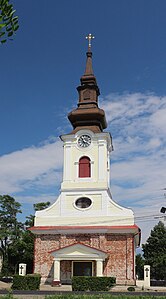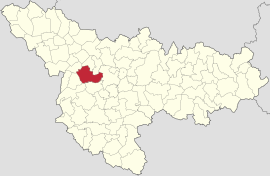| Săcălaz | |
|---|---|
| Commune | |
 The Orthodox church in Beregsău Mare The Orthodox church in Beregsău Mare | |
 Coat of arms Coat of arms | |
 Location in Timiș County Location in Timiș County | |
 | |
| Coordinates: 45°45′N 21°7′E / 45.750°N 21.117°E / 45.750; 21.117 | |
| Country | Romania |
| County | Timiș |
| Government | |
| • Mayor (2020–2024) | Viorel Nicu (PMP) |
| Area | 136.1 km (52.5 sq mi) |
| Population | 9,223 |
| • Density | 68/km (180/sq mi) |
| Time zone | EET/EEST (UTC+2/+3) |
| Postal code | 307370–307372 |
| Vehicle reg. | TM |
| Website | primariasacalaz |
Săcălaz (formerly Săcalhaz; German: Sackelhausen; Banat Swabian: Sacklass; Hungarian: Szakálháza) is a commune in Timiș County, Romania. It is composed of three villages: Beregsău Mare, Beregsău Mic and Săcălaz (commune seat).
Name
| Romanian | Hungarian | German | Serbian |
|---|---|---|---|
| Beregsău Mare | Berekszó | Großbergsau | Берексово/Bereksovo |
| Beregsău Mic | Berekszónémeti | Kleinbergsau | Немет/Nemet |
| Săcălaz | Szakálháza | Sackelhausen |
Geography
Săcălaz is located 10 km (6.2 mi) west of Timișoara and covers an area of 136.1 km (52.5 sq mi). The relief is flat. The Timiș River is the most important running water, Săcălaz also being crossed by the waters of two small streams, Beregsău Mare and Niarad.
History
Săcălaz was first mentioned in a diploma from 29 December 1392, in which the boundary of the village of Zakalhaza was delimited, a name that it kept until 1520. Following the Austro-Turkish War (1716–1718) the Banat localities became the property of the Austrian Imperial House. Banat became an autonomous Austrian province with military administration, being divided into 11 districts. In 1717 Săcălaz had 66 houses. The main occupation of the inhabitants was the cultivation of cereals, especially wheat and corn. In 1725, the first grain mill was built.
In 1765 the first wave of Swabian German settlers arrived here, by order of Maria Theresa. She issued the Kolonisationspatent of 25 February 1763 and later the Decree which she submitted to the Banat Colonization Office in 1765, ordering the relocation of the Romanian population to the southern part of Torontál County, to make way for the Swabian settlers. Thus, the Romanian population of about 60 families is forced to leave Săcălaz and move to Torak (in Serbian Banat), where they establish a new settlement. In turn, the village of Beregsău Mic was colonized with Serbs. The following waves of German settlers (1744–1772, 1782–1787) definitively established the German predominance of the locality. The plans for the development of Săcălaz were outlined on paper in Vienna, in the form of a chessboard, with the Catholic church in the center. The church was designed by engineer Carl Alexander Steinlein and was consecrated in 1772.
Demographics
Ethnic composition (2011)
Romanians (83.91%) Serbs (1.99%) Unknown (11.9%) Others (2.2%)Religious composition (2011)
Orthodox (78.87%) Pentecostals (7.38%) Roman Catholics (2.42%) Serbian Orthodox (1.78%) Unknown (7.12%) Others (2.43%)Săcălaz had a population of 7,204 inhabitants at the 2011 census, up 15% from the 2002 census. Most inhabitants are Romanians (83.91%), with a minority of Serbs (1.99%). For 11.9% of the population, ethnicity is unknown. By religion, most inhabitants are Orthodox (78.87%), but there are also minorities of Pentecostals (7.38%), Roman Catholics (2.42%) and Serbian Orthodox (1.78%). For 7.12% of the population, religious affiliation is unknown.
| Census | Ethnic composition | ||||
|---|---|---|---|---|---|
| Year | Population | Romanians | Hungarians | Germans | Serbs |
| 1880 | 6,218 | 1,935 | 97 | 3,245 | 926 |
| 1890 | 7,257 | 2,158 | 104 | 4,019 | 928 |
| 1900 | 7,475 | 2,087 | 197 | 4,202 | 948 |
| 1910 | 7,178 | 2,104 | 273 | 3,853 | 944 |
| 1920 | 7,141 | 1,855 | 174 | 4,169 | – |
| 1930 | 6,649 | 2,088 | 134 | 3,601 | 792 |
| 1941 | 6,700 | 2,212 | 60 | 3,553 | – |
| 1956 | 6,116 | 2,911 | 119 | 2,363 | 717 |
| 1966 | 6,774 | 3,674 | 140 | 2,303 | 645 |
| 1977 | 7,287 | 4,588 | 160 | 1,997 | 477 |
| 1992 | 5,926 | 5,368 | 111 | 76 | 293 |
| 2002 | 6,273 | 5,903 | 92 | 40 | 152 |
| 2011 | 7,204 | 6,045 | 67 | 41 | 143 |
Notable people
- Aurel Cosma (1867–1931), lawyer and politician
- Josef Linster [de] (1889–1954), composer, music teacher and folklorist
- Ernő Kállai (1890–1954), art critic
- Heinrich Lauer [de] (1934–2010), writer and journalist
- Karl Fritz Lauer (1938–2018), agronomist
- Gerhard Ortinau [ro; de] (b. 1953), writer
- Carl Gibson [de] (b. 1959), author and civil rights activist
References
- "Results of the 2020 local elections". Central Electoral Bureau. Retrieved 16 June 2021.
- ^ "Prezentarea comunei". Primăria comunei Săcălaz.
- "Populaţia rezidentă după grupa de vârstă, pe județe și municipii, orașe, comune, la 1 decembrie 2021" (XLS). National Institute of Statistics.
- "Ortschaften mit ehem. deutscher Bevölkerung im Banat". Jetscha.de.
- ^ "Scurt istoric". Primăria comunei Săcălaz.
- ^ Blejușcă, Ghiță (2009). Săcălaz. Timp și istorie. Timișoara: Artpress. ISBN 978-973-108-222-6.
- Reitz, Mathias (2006). Sackelhausen. Beiträge zur Geschichte einer deutschen Gemeinde im Banat. Reutlingen: self-published.
- Fett, Reinhold (1979). Sackelhausen – Heimatbuch einer Banater Gemeinde. Limburg an der Lahn: Limburger Vereinsdruckerei.
- ^ "Tab8. Populația stabilă după etnie – județe, municipii, orașe, comune". Institutul Național de Statistică.
- ^ "Tab13. Populația stabilă după religie – județe, municipii, orașe, comune". Institutul Național de Statistică.
- Varga, E. Árpád. "Temes megye településeinek etnikai (anyanyelvi/nemzetiségi) adatai 1880-2002" (PDF).
